
Preservation Self-Assessment Program
Tintypes
Risks of Handling/Use
Generally, handling and use heightens the risk of damage to your materials, be it through neglectful handling (e.g. touching photo emulsion with bare hands) or irresponsible operation of access equipment. This is a risk posed by patrons and staff alike, intentional or not.
Handling and Collections Care
One of the easiest areas to implement protections for collections is through careful handling and sensible collections care. The unfettered use and handling of materials heightens the general risk of damage--be it through neglectful handling (e.g. touching photo emulsion with bare hands) or irresponsible operation of access equipment. Whether intentional or not, this is a risk posed by patrons and staff alike.
Examples of neglect, mishandling, and mismanagement include:
- Pressure-sensitive (such as "Scotch®" brand) tape to mend tears.
- Permanent or volatile inks used to label documents (even the back side).
- Folding materials to fit into a given box or enclosure.
- Poor handling: Not washing and drying hands before handling fragile documents; or not using gloves when handling materials that could be damaged by contact with oils on the skin (for example: gloves must always be worn when handling metals).
- Inadequate storage or exhibit environments, such as areas with excessive climate swings or the use of poor display mounts.
- Inadequate packaging/padding for shipping
- Lack of bibliographic control over holdings, which has led to the harmful and excessive use of unique or vulnerable items.
General Recommendations:
- Use archival-quality folders, boxes, sleeves, and other enclosures to support and house materials of differing shapes and sizes. Avoid use of acidic containers such as brown paper bags and shipping or moving boxes.
- Use only Photographic Activity Test (PAT)-compliant storage enclosure materials for valuable photographic materials.
- Wear gloves (either cotton or nitrile) while handling archival photographic emulsion materials and museum objects.
- Avoid wearing cotton gloves while handling particularly fragile or slippery items, since gloves can hamper tactile senses and lead to accidentally dropping and breaking objects.
- Handle fragile materials as little as possible.
- Use clean, dry hands with carefully trimmed nails to handle materials (even when wearing gloves).
- Use both hands and ask for assistance when handling/moving oversized materials.
- Remove jewelry and accessories, including anything hanging around the neck or clothes that may inadvertently come into contact with and damage materials, such as: necklaces, headphones, glasses hanging around the neck, nametags, scarves, rings, watches, bracelets, ties, loose sleeves, and belts. Avoid wearing loose clothing.
- During transport, use enclosures, supports, book carts, and other equipment as appropriate to minimize the risk to materials. Use materials like foam and snake supports to ensure that items are supported and do not come in contact with other items or with the sides of carts during transport. Always ensure sufficient assistance while transporting items.
- Only use pencils for direct labeling (e.g. on a photo verso) of paper, AV, and photographic materials or folders/enclosures. Never use or carry pens around items and materials.
- Ensure that patrons know and understand guidelines on proper handling of all fragile materials.
- Ensure that staff, volunteers, and patrons are adequately trained in handling collection materials.

Additional Copies
The use of additional copies for reference or display purposes is highly recommended, particularly if the item is an original or valuable. This provides broader access to the content while also protecting the original document from user wear and tear or environmental factors.
Recommendations for care of original object:
- Ideally, originals should be used once to produce an access copy, facsimile, or surrogate;
- Copies would then be put to use by the institution in place of the original, sustaining the wear and tear of patron use or prolonged exhibition.
To learn more about best practices for use and access, including resources for creating digital surrogates, see Use & Access in the User-Manual.
Orientation in Storage
Store vertically with dividers between each slide. May also be stored horizontally (flat). Enclosures and folders may be stored in hanging files or archival storage boxes.
Storage Container
Acid-free enclosures and/or folders strongly advised. Each tintype should have its own enclosure to protect it from dust, handling damage, and changes in environmental conditions. Tintypes with flaking emulsions should be stored flat and stored in low humidity. Loose tintypes in good condition are best stored in a sturdy four-flap enclosure; if cased, they are best stored in acid-free tissue and placed in a folding box to prevent breakage and abrasion.
Display Recommendations
The duration of an exhibit should be determined in advance, and no item should be placed on display permanently. Most items should not be displayed for longer than 3 to 4 months, assuming other conditions like light levels, temperature, and relative humidity are within acceptable ranges. Facsimiles or items of low artifactual value may be exhibited for longer periods of time. Between display periods, they should be returned to an appropriate environment where they may "rest" in dark storage.
Light levels should be kept as low as possible. When on display, objects should be protected from exposure to natural light, which contains high levels of UV radiation. Shades, curtains, or filters applied directly to windows will help to minimize this exposure. This is particularly important for tintypes, which are very sensitive to light.
Display cases should be enclosed and sealed to protect their contents, and their items should be securely framed or matted using preservation-quality materials that have passed the Photographic Activity Test (ISO18916).
For more information on exhibition management, see Exhibition Guidelines.
Labeling
If your item has any kind of labeling on the container, the item itself, or any related material, we highly recommend that you return to the Basic Info section and enter this information in the appropriate field(s).
Physical Damage
The thin iron support of a tintype is vulnerable to mechanical damage as it is easily bent and abraded. A tintype found today will likely be found loose and therefore dented, bent, or scratched up. The collodion binder and varnishes are sensitive to light; they will yellow or perhaps delaminate under intense light exposure.
Mold / Pest Damage
Mold
If your item is exhibiting white or brown patches or if you see a lattice-like growth along the edges, you are most likely viewing mold. Items stored in hot, humid environments (generally above 65% relative humidity) are most vulnerable to mold, mildew, and fungus contamination. Mold will typically damage the edges of photographic material first. If mold has eaten into the emulsion, the item will be noticeably and irreparably damaged, exhibiting feathery-like distortions or dull spots on the projected image. Mold can be removed through cleaning and then storing the items in a cold, dry environment, but this should be done responsibly.
Pests
Pests like insects and rodents tend to like paper and textile materials more than copper-based materials. That said, pests can still do damage. When assessing the exposure of your collections to pests, it is necessary to look not just at the materials themselves and their containers, but also at the larger environment. Insects and rodents tend to leave droppings in areas they inhabit. Insects tend to leave behind a substance called frass, which is the undigested fibers from paper. If you see droppings and/or frass in the storage area, it is a strong sign that your materials are being exposed to pests. Small, irregular holes on paper-based enclosures are also a sign that pests have attacked your materials.
Some tips for reducing your materials' exposure to pests are to refrain from eating anywhere near your collections materials. Crumbs and food waste draw pests, so eat far from your collections. Another tip applying to both pests and mold is to be cautious about donated materials when you receive them. Pests and mold can hitch a ride into your facility on these materials, so having a good, clean staging area where you can inspect donated items for, among other things, pest and mold evidence can help you reduce your storage environments' exposure to both.
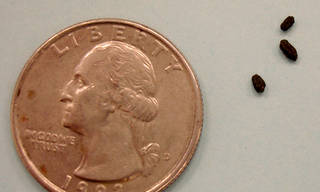
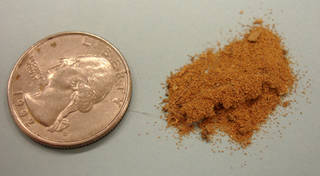
Rusting
The most significant preservation risk to tintypes is exposure to water and high humidity, which will lead to oxidation and rusting. This, in turn, causes blistering, flaking, and total loss of the image emulsion layer. If placed on a secondary paper support or in a sleeve, rust stains may show on its back side.
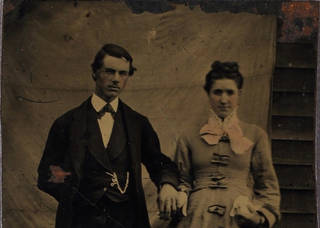
Casing
Tintypes were occasionally placed in small hinged cases but were more typically inserted into folding cards or envelopes/window mats made of paper or metal. If found today, they will mostly be loose.
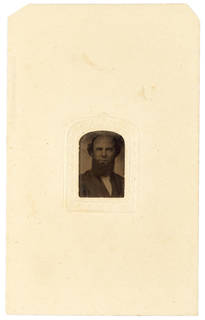
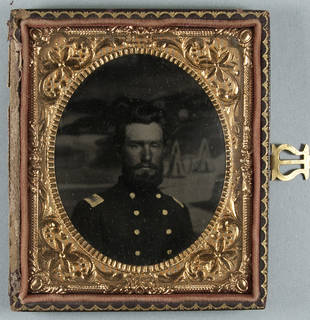
Darkening, yellowing and/or loss of contrast
The most significant preservation risk to tintypes is exposure to water and high humidity, which will lead to oxidation and rusting. This, in turn, causes blistering, flaking, and total loss of the image emulsion layer. The collodion binder and varnishes are sensitive to light; they will yellow or perhaps delaminate under intense light exposure.